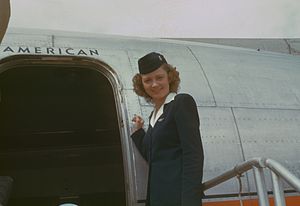Remember the old image of flying in an airplane? The smoky cabin, everyone dressed in suits, the stewardesses pretty and amiable. Everything with the nostalgic sheen of an episode of Mad Men. Flying was the purview of the wealthy and the hardworking. It wasn’t for the common man.
Of course, those that fly routinely know today’s feeling is something like a cattle-car; each person squeezed together, after the indignity of choosing to be patted-down or walking through a giant X-Ray in which you “assume the position” of guilt (hands up and legs spread). Nothing says high-class and good times like bearing all that you are—and of course, removing your shoes and belt.
A recent flight brought this all to my consciousness because for the first time, I was on a flight with three male flight attendants and only one woman. This is not significant by itself, of course; and it is clearly a common occurrence for the frequent flyers among us.
What it reminded me of was the subtle shift in not only priority, but in operations in the airline industry. The old way glorified youth, beauty and service. It was an expensive luxury for those that could afford to participate and fully represented the cultured-class. From the onboard meals, to the serving of alcohol, the very nature of flying was decadent and pampering.
It isn’t that way anymore, is it? Now the planes are designed to offer the least amount of space for you as they can get away with, nothing is free, and the entire process is something of a challenge to each passenger’s will power. But I don’t long for the old days, by any means. The priorities have changed. Look at the difference in the flight attendants and you can see how:
- Before: youth/beauty/service
- Now: experience/access/safety
In the old way, the passenger is supposed to feel comfortable; now she is meant to feel safe. Instead of beautiful waitresses, we have experienced professionals.
The funny thing is that this happened without fanfare and without the public throwing any kind of fit. There was no political battle over it and no claims of some evil political correctness police daring to try and make people (gasp!) just and considerate. We went to sleep in the 70’s and woke in the 10’s to find the world is different. And that old way seems archaic, doesn’t it? A little unseemly. Perhaps a tad creepy, actually; the image of old men staring at 20 year-old women is no longer “expected” is it? The old way doesn’t fit. And at the same time, the new way makes sense and feels right, if not with a whiff of “new plane smell”.
I wonder what this means for society and for church? I wonder if our patterns and practices from the 1960s and 70’s feel as stale as that old image of the stewardess. And what of transforming our witness for the 10’s—transforming to something that is less about youth, beauty, and service, but about real experience, access, and safety. I wonder if we wouldn’t be more comfortable in a church like that. And for those that are stuck in the 1970s, I have only one question: why?

Leave a Reply